Diary of Painting with Ken Howard in India – February 2015
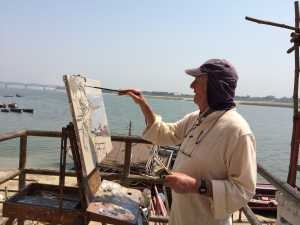
28th February 2015
We assembled at Heathrow and managed to gather for a drink in the departure lounge where old friends were re-united and new ones got to meet Ken Howard RA. In spite of his Royal Academician status he really is the most engaging and unassuming man and we all boarded our flight to Delhi safe in the knowledge that we would be in good company for a fortnight.
1st March
We landed in Delhi in the drizzle. After a short drive to our delightful colonial-style hotel, Claridges, we were shown to our elegant rooms. After a brief nap we gathered in the reception area for a wander up the road to Gandhi’s house and museum. Our hotel was situated in the embassy district and Gandhi’s house was a grand affair but furnished modestly as befitted the great man’s humility. However the museum’s curators did not seem to believe in simplicity and had filled the house with dubious tributes and art-work. Beneath the surface there was enough genuine historical material to make it interesting however.
We gathered for pre-dinner drinks in the hotel bar and met up with two additional members of the group who had flown in from Australia and Taiwan respectively. Ken Howard’s excellent reputation clearly extends across the globe and Spencer Scott’s art trips are nothing if not international! We had Canadians in our party too and the conversation flowed freely first over drinks and then dinner as art and painting styles were discussed.
2nd March
We took an internal flight to Udaipur. It is one of those iconic places that is familiar from a thousand tourist posters and yet takes your breath away when you actually see it. A Maharana built a palace complex on the shores of man-made Lake Pichola in the 16th century and a wayward descendant of his built his own palace (Jag Niwas) on an island a short distance off-shore in the mid-18th century.
Our hotel, the Fateh Prakash, was part of the City Palace complex, one wing of which was still lived in by the current Maharana. It was an opulent and majestic building with lush vegetation and elegant courtyards. We were given a Royal welcome and were festooned with orange garlands.
Dinner was taken on the appropriately named Sunset Terrace with views over the lake surrounded by low, undulating hills with the lights of Jag Niwas, now a luxury hotel in its own right, twinkling beneath us; a gleaming white palace looking for all the world like a luxury cruise ship ready to set sail.
With our first destination reached and the drizzle of Delhi replaced by perfect, dry conditions, it was time to discuss painting spots and subjects…
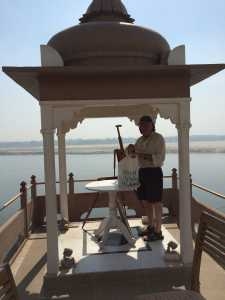
3rd March
Ken had been to Udaipur before and was keen to return to one of his favourite spots near Amba Pol which lay across the lake providing a view across to the City Palace where we were staying. Ken likes to catch the early light so after a copious breakfast on the Sunset Terrace (the sunrises were magnificent there too!) an advance party set off in a couple of Tuk Tuks for Amba Pol.
A temple lay by the lake with some steps leading down to the water’s edge (a “ghat”) where some rather bemused bathers watched as a bleary-eyed group set up their easels.
Ken, as always, painted a seemingly effortless masterpiece. As an artist he is known to say that he would quite happily return to the same spot repeatedly, rather as Monet did with Rouen Cathedral, as it is always different under new weather and light conditions. This spot became one of his favourites during the week.
4th March
Ken returned to Amba Pol. Some members of the group joined him while others wandered a little further along the lakeshore to the appropriately named “Wonder View”. At 5 o’clock we assembled for a boat trip around the lake and we went ashore on Jag Mandir Island where the view of Udaipur in the distance bathed in golden evening light was quite magical. We visited the Gul Mahal, a domed pavilion that had provided refuge to a prince who later became Shah Jahan, builder of the Taj Mahal. Was it too fanciful to see an influence of its modest dome on the more famous structure?
Our guide also told us about the imminent Holi celebrations and upon returning at sunset we were whisked out of town by coach to a restaurant that had been a Colonial Club in the days of the Raj on the outskirts of town. A collection of Spode China lined the walls rather incongruously and it wasn’t too much of a stretch of the imagination to conjure up colonial administrators and their prim Memsahibs languishing beneath the fans on the verandah…
5th March
Ken adopted a new spot at Chand Pol (Moon Gate) on our side of the lake directly opposite Amba Pol. Here there was a choice of view, either of the triple-arched gate itself or of a domed structure known as a “chhatri” bordering the lake.
In the evening most of the group attended the City Palace’s Holi Celebrations in the largest of the Palace’s courtyards. The Maharana himself attended and local dignitaries paid homage to him while we watched from a terrace above.
There was a full moon so the entire proceedings were bathed in silvery light while fairy lights twinkled in the trees and bushes.
Holi is always celebrated at full moon at a time when winter gives way to spring. It is based on an ancient myth concerning a malevolent King whose son was a devotee of Lord Vishnu. The boy’s older sister, Holika, had been granted dispensation by the gods from fire and took her younger brother into a fire with her. Her life was sacrificed and is commemorated by a bonfire while her brother escaped unscathed. It is a celebration of good over evil.
At the end of the ceremony we were treated to a buffet with what the Indians charmingly called “hearty snacks”. All in all it was quite a visual and gastronomic feast with the lofty white stone of the City Palace providing a stunning backdrop for the festivities.
6th March
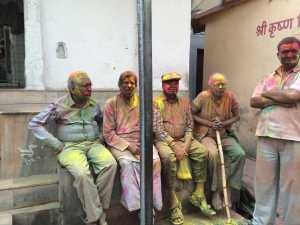 If the first day of Holi celebrates the triumph of good over evil, the second day is an expression of universal brotherhood and strengthening of the secular fabric of India. According to the explanation provided with our ceremony tickets “Gukal, or coloured powder signifying the hues of spring is sprinkled liberally on friends, family and strangers dissolving all differences of status, age, gender and class.” The technicolour pyramids of powder paint for sale in the streets had alerted us to the dangers of going out during this particular festival. Some hotel guests had bought white clothes specially for it and returned to the hotel spattered in a multitude of colours with even their faces an array of vibrant shades. Our guide had warned us to stay in the hotel complex until 3.00 unless we wanted to have our clothes completely re-designed. But the stunning architecture of the City Palace provided plenty of painting subjects until it was safe to venture out into the streets after 3 o’clock. They were eerily quiet with just the odd cluster of brightly coloured people and even the sacred cows that meandered about had bright marks on their backs where they had got caught up in the paint-throwing crossfire. An attempt to paint at Chand Pol proved difficult for all but the most determined as some revellers had gathered there and were a little disruptive. Ken carried on doggedly of course!
If the first day of Holi celebrates the triumph of good over evil, the second day is an expression of universal brotherhood and strengthening of the secular fabric of India. According to the explanation provided with our ceremony tickets “Gukal, or coloured powder signifying the hues of spring is sprinkled liberally on friends, family and strangers dissolving all differences of status, age, gender and class.” The technicolour pyramids of powder paint for sale in the streets had alerted us to the dangers of going out during this particular festival. Some hotel guests had bought white clothes specially for it and returned to the hotel spattered in a multitude of colours with even their faces an array of vibrant shades. Our guide had warned us to stay in the hotel complex until 3.00 unless we wanted to have our clothes completely re-designed. But the stunning architecture of the City Palace provided plenty of painting subjects until it was safe to venture out into the streets after 3 o’clock. They were eerily quiet with just the odd cluster of brightly coloured people and even the sacred cows that meandered about had bright marks on their backs where they had got caught up in the paint-throwing crossfire. An attempt to paint at Chand Pol proved difficult for all but the most determined as some revellers had gathered there and were a little disruptive. Ken carried on doggedly of course!
7th March
The very last day in Udaipur…
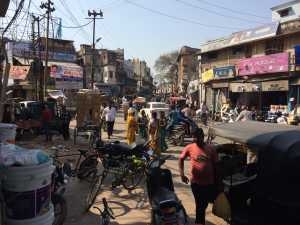 Although Ken limited his paintings to the two spots I have mentioned, other members of the group chose the street scenes available as soon as you stepped out of the City Palace gates. There you found Indian life in all its colourful splendour with Tuk tuks, women in brightly coloured sarees and the bustle and vigour of a prosperous little Indian town. Many of the houses close to the City Palace complex had been built for Royal retainers and had exquisite wall-paintings.
Although Ken limited his paintings to the two spots I have mentioned, other members of the group chose the street scenes available as soon as you stepped out of the City Palace gates. There you found Indian life in all its colourful splendour with Tuk tuks, women in brightly coloured sarees and the bustle and vigour of a prosperous little Indian town. Many of the houses close to the City Palace complex had been built for Royal retainers and had exquisite wall-paintings.
As we gathered for our final dinner at the Sunset Terrace we agreed that Udaipur had a particularly magical quality and a light, airy, elegant feel…
8th March
Regrettably it was time to leave this earthly paradise. The hotel despatched us at crack of dawn with packed breakfasts and we caught an early morning flight to Varanasi via Delhi.
A coach met us at the airport and the guide festooned us with marigold garlands. Then we pulled up by the River Ganges where our luggage was transferred onto a boat and we set sail along the river to Varanasi.
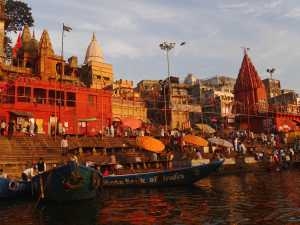 Our hotel, the Jukaso Ganges was directly on the riverfront. It was a Heritage Hotel built in an ancient building with an inner courtyard and even its own temple. However, it was such a holy site that alcohol was prohibited in most areas of the hotel including the restaurant with a dispensation allowing it to be consumed only in bedrooms!
Our hotel, the Jukaso Ganges was directly on the riverfront. It was a Heritage Hotel built in an ancient building with an inner courtyard and even its own temple. However, it was such a holy site that alcohol was prohibited in most areas of the hotel including the restaurant with a dispensation allowing it to be consumed only in bedrooms!
Once we had settled into our rooms Ken led us for a pre-dinner walk along the Ganges. Over a hundred “ghats” lead down to the Holy River Ganges. It is a sacred river for Hindus who like to have their ashes scattered in the river. A short distance away we came to the “Burning Ghat” where an estimated 150 bodies a day are cremated. We soon got used to the processions of mourners carrying their beloved aloft on stretchers draped in orange shrouds heading for the funeral pyres.
Over dinner some of the group felt a little subdued as this was a world away from Udaipur and a little out of our comfort zone…
9th March
Ken had been to Varanasi before and soon found subjects almost immediately outside the hotel door. One favourite was a leaning temple between our hotel and the Burning Ghat which became popular with other members of the group too. He had the additional challenge of being filmed while working together with two other British painters, Peter Brown and Patrick Cullen who had just arrived in town and were staying in a hotel a little further along the river.
10th March
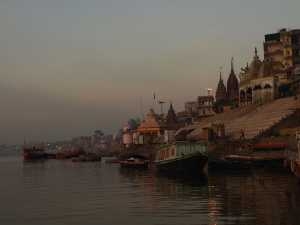 While Ken continued to work along the waterfront from first thing in the morning until late afternoon, his friend Peter Brown (nicknamed “Pete the Street”) was as good as his name and worked in the streets of Varanasi. There was a labyrinth of streets around the back of the riverfront properties which could only be negotiated with the assistance of a pair of brothers available at the hotel reception. These young men could also carry easels and equipment and fend off curious bystanders. They became invaluable to us all.
While Ken continued to work along the waterfront from first thing in the morning until late afternoon, his friend Peter Brown (nicknamed “Pete the Street”) was as good as his name and worked in the streets of Varanasi. There was a labyrinth of streets around the back of the riverfront properties which could only be negotiated with the assistance of a pair of brothers available at the hotel reception. These young men could also carry easels and equipment and fend off curious bystanders. They became invaluable to us all.
11th March
Some of the painters were starting to flag at this stage and took advantage of the availability of the street-wise brothers to go inland to the Muslim area where the renowned Varanasi silk-trade is based. There we were shown how cardboard punch-cards were processed and then antiquated machinery (electric but that was its only concession to modernity) whirred and clattered producing gorgeous iridescent silks for sarees and sturdier woven fabrics for men and women alike. It was an eye-opener for us all. The Tuk Tuk journey there and back was an experience in itself. The Main Street was a jumble of Tuk Tuks, bicycle rickshaws and delivery vehicles all weaving in amongst each other with consummate skill but miraculously never colliding.
One trophy purloined from town by the resourceful brothers was a case of Kingfisher beer. We assembled in Ken’s room – ironically Room 101 – at 7.00 for our illicit party and were joined by artists Pete Brown and Patrick Cullen as well as cameraman Neale who was making a film about Ken. We enjoyed our refreshing beers and then adjourned to the hotel dining room for dinner with our artistic guests who provided a lot of additional banter and observations on the challenges of painting in India, no easy feat for Pete especially who true to his nickname had been painting in the street and jostling for space with the vehicles, the hawkers and the downright curious.
12th March
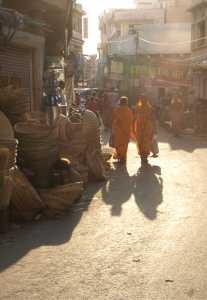 This morning it wasn’t just Ken who rose at dawn. We all rose before breakfast for a boat trip along the Ganges. The river was calm and serene with just a few other boats out on the water. We observed the red orb of the sun rise up above the opposite shore which was devoid of buildings and then saw our own side of the river become illuminated by the glow of the morning sun. We watched as Varanasi became infused with life once more and people bathed from the ghats, cleaned their crockery, washed their clothes and yes, even the first pyres began to be constructed at the Burning Ghat. We went ashore to see the sacred Golden Temple from the outside (only Hindus are allowed inside) and then we were rowed back along the river to a welcoming breakfast in our hotel.
This morning it wasn’t just Ken who rose at dawn. We all rose before breakfast for a boat trip along the Ganges. The river was calm and serene with just a few other boats out on the water. We observed the red orb of the sun rise up above the opposite shore which was devoid of buildings and then saw our own side of the river become illuminated by the glow of the morning sun. We watched as Varanasi became infused with life once more and people bathed from the ghats, cleaned their crockery, washed their clothes and yes, even the first pyres began to be constructed at the Burning Ghat. We went ashore to see the sacred Golden Temple from the outside (only Hindus are allowed inside) and then we were rowed back along the river to a welcoming breakfast in our hotel.
After dinner we all assembled in the hotel’s magical courtyard for Ken’s Slideshow and talk. An antiquated Kodak slide projector had been sourced from the back streets of Varanasi (Ken most definitely isn’t a PowerPoint man!) He held us all spellbound with an illustrated talk about his artistic life, starting with his early days in North London and going through his years of National Service when he got to paint regimental portraits, through to his gruelling period as a war artist in Northern Ireland and in later years the serenity of Venice and Cornwall among other places when Ken’s mastery of light effects and sparkling water really came into their own. It was a visual feast for us all, delivered as always in Ken’s inimitable relaxed and accessible style.
13th March
Undaunted by the stunning images we had seen on screen the night before, it was time to polish off any unfinished pieces and show the rest of the group what we had achieved in the fortnight. There was a spacious temple off the hotel courtyard which the staff allowed us to use prior to dinner on the proviso that we left our shoes outside. The group lined their works around the walls and on flat surfaces and then the barefoot Private View began. As always with Spencer Scott art trips there were hidden gems on display as not all the group members work alongside the guest artist, many choosing to observe the art host at work and then find their own subjects each day. Many different aspects of Udaipur and Varanasi were on display: palaces, street scenes, ghats in both places, temples, holy cows… There were studies of people at work and paintings utterly devoid of people. There were people who had worked entirely outside and others who had completed their works in the cool conditions of their room. Most had worked in oils like Ken while others had used watercolour or pastel. Each and every person had interpreted the two places in an entirely different way and had a body of work to be proud of.
14th March
This was our last day in Varanasi and a chance to finish off paintings or simply to buy souvenirs for family and friends.
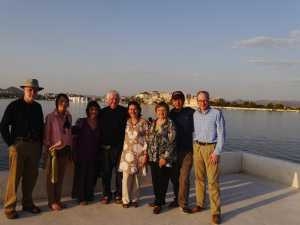 But our last evening was to be celebrated in style with an evening boat trip along the Ganges where we moored alongside other boats and watched the “Aarti” religious ceremony on shore. Aarti means prayer or blessing and it was an event that took place every evening to give thanks for the mighty River Ganges. We sat mesmerised in our boat as lights glinted in the water and the incomprehensible chanting of the Hindu holy men drifted across to us. Nimble boys of about 7 or 8 hopped across from one boat to the next selling floating candles. We threw these in the water as we left and they bobbed about together with those from adjacent boats looking for all the world like cats’ eyes in the inky black water of the Ganges.
But our last evening was to be celebrated in style with an evening boat trip along the Ganges where we moored alongside other boats and watched the “Aarti” religious ceremony on shore. Aarti means prayer or blessing and it was an event that took place every evening to give thanks for the mighty River Ganges. We sat mesmerised in our boat as lights glinted in the water and the incomprehensible chanting of the Hindu holy men drifted across to us. Nimble boys of about 7 or 8 hopped across from one boat to the next selling floating candles. We threw these in the water as we left and they bobbed about together with those from adjacent boats looking for all the world like cats’ eyes in the inky black water of the Ganges.
Then we moored a little further upstream and joined Patrick and Pete in their hotel, the Dolphin. They had a visual feast of their own having laid out their paintings on their beds and we paused there on our way up to the rooftop terrace to observe what they had accomplished. Then, fortified by their masterpieces, we clambered up the remaining stairs to the Dolphin’s rooftop terrace. Our own hotel, the Jukaso Ganges had a serenity and a Zen-like calm which it would be fair to say The Dolphin lacked. Our hotel also had a lift which was a bonus. But our hotel was a holy site next to the Ganges and didn’t have an alcohol licence. So we had learnt to enjoy teetotal dinners in our hotel with those who wanted something stronger, storing Kingfisher beers in their fridges as room consumption was permitted. At the Dolphin restaurant however, beer and wine flowed freely and we spent an enjoyable evening comparing notes about painting in India and the trip generally while the lights of Varanasi and the hurly-burly of the ghats, still busy at this hour, glimmered down below.
Our boatman took us back, past the Burning Ghat one more time where the funeral pyres still smouldered, glowing brightly in the night sky.
Then it was time to settle bills and complete packing for those who had not already done so prior to our departure the next day.
15th March
Unlike our indecently early departure from Udaipur, we had a civilised departure time from Varanasi. But having enjoyed utterly dry conditions in both places with the last rainy day in Delhi a fortnight earlier, we were greeted with rain on this final morning. Normally this would not be an issue on the day of an airport transfer but given that the first half of the journey was to be undertaken on an open motorboat with a second boat lashed to its side containing the cases, this was potentially a challenge. The group sheltered under a canopy on the main boat while the cases were wrapped in an assortment of bin bags and finally a tarpaulin for protection. Particularly vulnerable were Ken’s paintings in trademark cardboard packaging held together with brown packing tape and string (we all suggested a slim suitcase as a solution but he swears by this makeshift contraption!) Once we had moored near the coach an assortment of young men whisked our cases and Ken’s precious cargo up to the vehicle and we embarked for the road journey to Varanasi airport.
Once we had checked in we had the pleasure of briefly seeing our artist friends who were bound for a later flight. Information was swapped about forthcoming exhibitions and we then made our way to the gate and the short flight to Delhi.
Claridges Hotel seemed particularly deluxe and the diplomatic quarter surrounding it breathtakingly lush and verdant. We enjoyed an international-style buffet at dinner washed down with alcohol for those who wished it and joined Ken in the bar for a final drink.
16th March
After breakfast it was time to head off to Delhi airport and board our flight to Heathrow. Needless to say it was grey and cold. The warmth and colour of India seemed a world away. Fortunately each member of the group had a stack of paintings in addition to photos evoking the magic of India and contrasting experiences of Udaipur and Varanasi. Final farewells were uttered and promises made to keep in touch. Ken assured us he would be holding a reunion in his London studio in the autumn and fortified by this we all dispersed to waiting taxis and family members. It was a magical experience and a truly unforgettable trip…
Words and images by Jane Langley, who accompanied this trip for Spencer Scott Travel

